- 01 SEPTEMBRE
INDI-UNI :ANTHROPOLOGIE - ARCHEOLOGIE
INSCRIPTION 2011 – 2012 COURS A DISTANCE
REGISTRATION 2011 – 2012 ONLINE COURSES
- FRANCE – 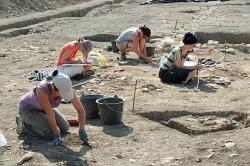 Roquelaure - Au pied du château d'eau de Roquelaure, en haut de la colline, les vestiges de l'ancien palais dominent la plaine, le regard tourné vers Auch, la cité préfecture. Philippe Gardes, responsables du chantier, était venu fouiller un ensemble gaulois avec son équipe d'une vingtaine de personnes, mais il est tombé sur un palais romain. Il a été construit sous le règne de l'empereur Auguste, vers - 20 avant Jésus-Christ. "Ce palais n'a rien à faire là, c'est une construction typiquement italienne", explique Philippe Gardes. Le plus impressionnant, ce sont les fresques de 3,50 mètres de haut retrouvées sur le site, encore à l'envers pour le moment. Il juge ce site d'envergure nationale car il est remarquable par sa construction maçonnée alors qu'à cette époque le bois et le torchis étaient la règle.
Roquelaure - Au pied du château d'eau de Roquelaure, en haut de la colline, les vestiges de l'ancien palais dominent la plaine, le regard tourné vers Auch, la cité préfecture. Philippe Gardes, responsables du chantier, était venu fouiller un ensemble gaulois avec son équipe d'une vingtaine de personnes, mais il est tombé sur un palais romain. Il a été construit sous le règne de l'empereur Auguste, vers - 20 avant Jésus-Christ. "Ce palais n'a rien à faire là, c'est une construction typiquement italienne", explique Philippe Gardes. Le plus impressionnant, ce sont les fresques de 3,50 mètres de haut retrouvées sur le site, encore à l'envers pour le moment. Il juge ce site d'envergure nationale car il est remarquable par sa construction maçonnée alors qu'à cette époque le bois et le torchis étaient la règle.
http://www.sudouest.fr/2011/09/01/roquelaure-32-decouverte-d-un-site-archeologique-d-interet-national-487976-2583.php
- SAINT VINCENT / GRENADINES - SVGdigs and The SVG Public Archaeology Program was created in June 2010 as a not-for-profit venture to help rescue and record significant archaeology on the Caribbean island of St. Vincent in St. Vincent and the Grenadines (SVG). Volunteers came from Alberta, Ontario, Florida, New Jersey and Greece, happily contributing to a successful 2011 season. Our results were significant, identifying further evidence of prehistoric structures and burials, one of which included the recovery (and restoration) of a complete pot whose vessel form had never before been identified in SVG and the Caribbean. Given the significance of our findings, and the extent of archaeology that remains, the International Airport Development Company (IADC) of SVG approved a 2012 season. This project is in thanks and cooperation with the SVG National Trust and the IADC, as well as Dr. Richard Callaghan of the University of Calgary.
http://www.shovelbums.org/index.php?option=com_sobi2&sobi2Task=sobi2Details&sobi2Id=605&Itemid=89
- FRANCE - 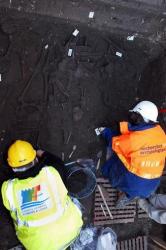 Tours - Rue Charles-Gille, les travaux du tram ont permis de mettre au jour une fosse commune du XIV e siècle, une période où les épidémies étaient nombreuses. Rue Nationale, même si le champ des fouilles concerne finalement une portion restreinte, sous un collecteur d'eau pluviales en cours de démolition, les archéologues espèrent trouver le « lien » entre les vestiges d'habitations mis au jour lors des fouilles du parking Gambetta et les thermes antiques qui se situaient près du lycée Descartes.
Tours - Rue Charles-Gille, les travaux du tram ont permis de mettre au jour une fosse commune du XIV e siècle, une période où les épidémies étaient nombreuses. Rue Nationale, même si le champ des fouilles concerne finalement une portion restreinte, sous un collecteur d'eau pluviales en cours de démolition, les archéologues espèrent trouver le « lien » entre les vestiges d'habitations mis au jour lors des fouilles du parking Gambetta et les thermes antiques qui se situaient près du lycée Descartes.
http://www.lanouvellerepublique.fr/indre-et-loire/ACTUALITE/Infos-Departementales/Rue-Nationale-le-protocole-respecte
- ISLANDE – 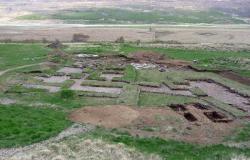 Vatnsfjördur - Archeologists and university students recently discovered an ancient gold necklace during an excavation project in Vatnsfjördur in Ísafjardardjúp in the West Fjords, which has been ongoing for the past eight summers. Vatnsfjördur was settled early in the Settlement Era, which sources state began in the 9th century AD, and later became the site of a manor and a chieftain’s residence. Many beautiful objects have been excavated in the course of the project.
Vatnsfjördur - Archeologists and university students recently discovered an ancient gold necklace during an excavation project in Vatnsfjördur in Ísafjardardjúp in the West Fjords, which has been ongoing for the past eight summers. Vatnsfjördur was settled early in the Settlement Era, which sources state began in the 9th century AD, and later became the site of a manor and a chieftain’s residence. Many beautiful objects have been excavated in the course of the project.
http://www.icelandreview.com/icelandreview/daily_news/Ancient_Gold_Necklace_Found_in_West_Fjords_0_381631.news.aspx
- INDE – Ramtek - The state department of archaeology has revised the proposal for conservation of the crumbling hill around the Gad mandir or temple at Ramtek. Though rocks from the hill are falling only on the south side, in a stretch of around 10 meters, conservation is urgently required. The Ram or gad mandir is supposed to be about 800 years old while the Varaha, Keval Narsimgha, Rudra Narsimgha and Boghram temples are around 14-15,000 years old.
http://timesofindia.indiatimes.com/city/nagpur/Ramtek-temple-conservation-plan-tweaked-again/articleshow/9816183.cms
- ROYAUME UNI – 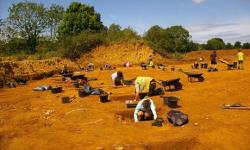 Ham Hill - The most intensive investigation ever undertaken of Britain's largest iron age hill fort is expected to reveal new details of how Britons lived 2,000 years ago – and maybe even that they were almost as suburban as we are. Stretching across 80 hilltop hectares, behind three miles of ramparts, the fort, at Ham Hill in Somerset, and the outline of its history have been known for many years. The Durotriges tribe, which lived on the hill, was subdued in AD45 by soldiers of the 2nd Legion under the command of the future emperor Vespasian, but what the Romans found there: a street system lined with houses on their own plots of land, is what archaeologists from Cambridge and Cardiff universities hope to uncover more fully in excavations over the next three summers. "There was a main road going through and regular enclosures with round houses in them – it looks rather like suburbia," said Christopher Evans, director of the Cambridge Archaeological Unit. As the ramparts were much too extensive for the occupants of the hill to defend on their own, attention is turning to whether the people who lived there were actually developing a community or collective identity for themselves. Although there have been bronze age finds from an earlier era, it is still not known when the hill was occupied and the ramparts built. The initial dig this summer has uncovered human remains, including one full skeleton and the bones of a dog, as well as artefacts from domestic life including tools and pottery. The inhabitants had paddocks for animals and grain storage pits.
Ham Hill - The most intensive investigation ever undertaken of Britain's largest iron age hill fort is expected to reveal new details of how Britons lived 2,000 years ago – and maybe even that they were almost as suburban as we are. Stretching across 80 hilltop hectares, behind three miles of ramparts, the fort, at Ham Hill in Somerset, and the outline of its history have been known for many years. The Durotriges tribe, which lived on the hill, was subdued in AD45 by soldiers of the 2nd Legion under the command of the future emperor Vespasian, but what the Romans found there: a street system lined with houses on their own plots of land, is what archaeologists from Cambridge and Cardiff universities hope to uncover more fully in excavations over the next three summers. "There was a main road going through and regular enclosures with round houses in them – it looks rather like suburbia," said Christopher Evans, director of the Cambridge Archaeological Unit. As the ramparts were much too extensive for the occupants of the hill to defend on their own, attention is turning to whether the people who lived there were actually developing a community or collective identity for themselves. Although there have been bronze age finds from an earlier era, it is still not known when the hill was occupied and the ramparts built. The initial dig this summer has uncovered human remains, including one full skeleton and the bones of a dog, as well as artefacts from domestic life including tools and pottery. The inhabitants had paddocks for animals and grain storage pits.
http://www.guardian.co.uk/science/2011/sep/01/iron-age-hill-fort-excavation
- INDE – 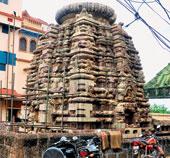
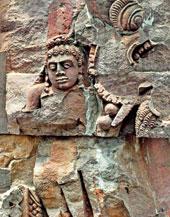 Bhubaneswar - A beautiful location and an aesthetic design make Markandeswar temple a unique heritage site. But the eighth century temple that stands alongside Bindusagar tank lies in neglect and faces threat from urban vandalism despite being a protected site under the Archaeological Survey of India (ASI). According to Sadasiba Pradhan, an archaeology expert, Markandeswar temple is significant because of its construction that dates back to the formative years of Orissa’s temple building style. The features that include detailed carvings of mythological characters as well as of dancers and male and female figures can be compared to the features of the intricate craftsmanship of Vaital temple and Parasurameswara temple. The temple is made of sandstone while the boundary wall is made of laterite.
Bhubaneswar - A beautiful location and an aesthetic design make Markandeswar temple a unique heritage site. But the eighth century temple that stands alongside Bindusagar tank lies in neglect and faces threat from urban vandalism despite being a protected site under the Archaeological Survey of India (ASI). According to Sadasiba Pradhan, an archaeology expert, Markandeswar temple is significant because of its construction that dates back to the formative years of Orissa’s temple building style. The features that include detailed carvings of mythological characters as well as of dancers and male and female figures can be compared to the features of the intricate craftsmanship of Vaital temple and Parasurameswara temple. The temple is made of sandstone while the boundary wall is made of laterite.
http://www.telegraphindia.com/1110831/jsp/orissa/story_14444889.jsp